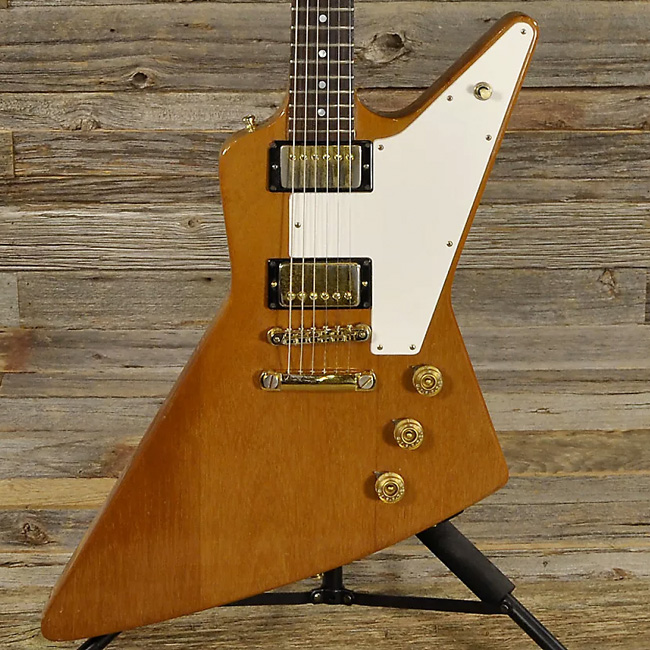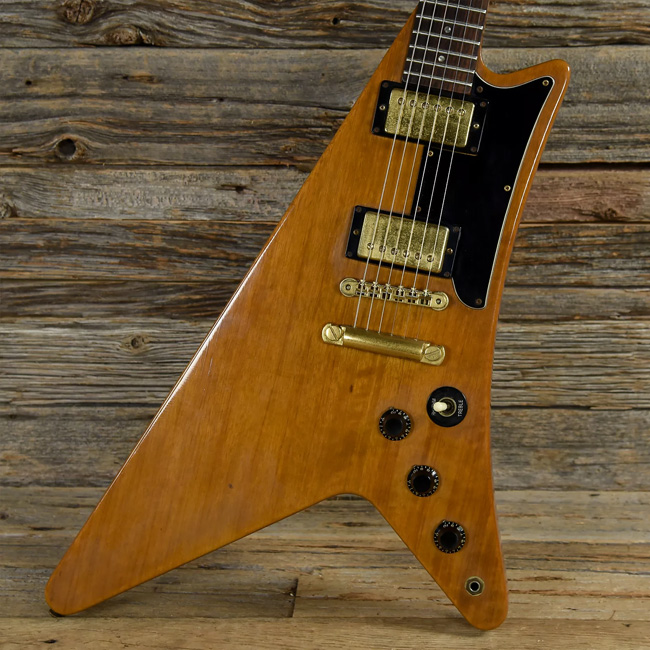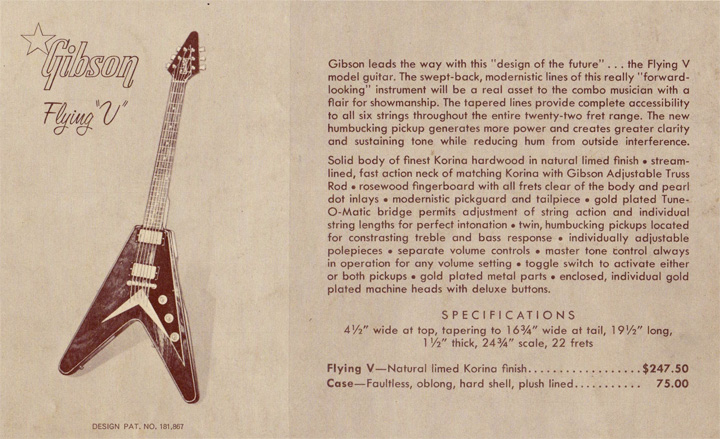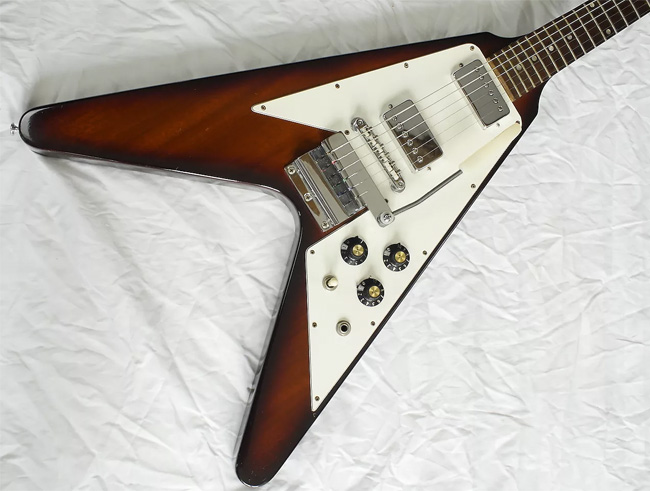It was Seth Lover at Gibson who first sketched out a rough shape for a new guitar design with an unusual pointed body, and it was Seth, too, who gave the instrument its name: the Flying V.
Seth was used to coming up with important new items for the company. A little earlier, he’d devised Gibson’s humbucking pickup, and two of those sat proudly on the V when it debuted early in 1958, almost exactly 60 years ago as you read this. It was the most revolutionary electric guitar that had ever been made.

There was an unwritten law that the body of a guitar had to follow a traditional shape. Until the V, virtually every guitar—other than some lap steels—had familiar rounded outlines to the body, with an upper and lower bout straddling a waisted middle. This symmetrical figure-of-eight shape led to the cliché about a guitar being like a woman’s body.
Guitars had been this shape for a long time, since their roots in earlier centuries. Every guitar more or less copied the standard template.
Gibson was not known for revolutionary moves. It was seen more as a safe, successful Midwest manufacturer. But the firm’s managers were well aware of the growing success of Fender, and the initial reaction to that perceived threat had been Gibson’s Les Paul, first seen in 1952 and something of a solidbody version of Gibson’s traditional archtop style.
Over on the West Coast, Fender continued to turn out solidbodies that looked bright and modern, especially the new Stratocaster model that had been doing well since its introduction in ’54. The Strat seemed excitingly new and it had a modern, space-age name.
Gibson had to compete further, and so Seth came up with three potential new designs intended to dispose of the firm’s reliance on the conventional old guitar shapes and to introduce instead a shockingly new, of-the-moment vibe. We now know those three designs as the Flying V, the Explorer, and the Moderne (which was then shelved and not produced until 1982). Gibson called them collectively the Modernistic guitars.


The V was the first to go into production, and the company previewed it in the November 1957 issue of the Gibson Gazette, its promotional magazine. Around March 1958, the V made its debut in the Gibson catalogue, where the list price for the new model was $247.50 USD (roughly equivalent to a little more than $2,000 in today’s money).
This put it at exactly the same price as the Les Paul Goldtop, around the middle of Gibson’s price points for electric guitars. The $700 Super 400 CES hollowbody in natural finish was at the top, with the $120 Les Paul Junior in sunburst down at the bottom. Over at Fender, the Strat listed a touch higher than the V, at $274.50, while the Telecaster was quite a bit lower, at $199.50.
It was that remarkable V-shaped body that drew most attention. “Gibson leads the way with this design of the future," the catalogue blurb declared. “The swept-back, modernistic lines of this really forward-looking instrument will be a real asset to the combo musician with a flair for showmanship."
The design used straight lines in place of traditional curves, and the V’s headstock was something like the body shape in miniature, a variant on the traditional Gibson three-tuners-to-each-side design, with a wide base that tapered in a V shape to a rounded tip.

Messing with the regular guitar shape in this spectacular fashion underlined the notion that the body of a solidbody electric is potentially the least important contributor to the instrument’s tonal qualities. Developing that idea further, you might conclude that a body could be any shape. It was the Flying V that made that clear for the first time.
Gibson’s ’58 catalogue added some info about the material the V was made from, the “finest Korina hardwood in natural limed finish." Korina was an American tradename for a West African hardwood, Terminalia superba, usually known as limba or afara. It’s sometimes compared to mahogany, because of its average weight and its tonal characteristics for solidbody guitars, but it’s a different species and family.
Gibson seems to have chosen it mainly for its appealing look and light color, giving it almost a Fender blonde-like appearance, but not needing the extra work that mahogany would require to get a similar effect. Gibson was already using pale Korina for its Skylark lap steel, introduced in 1957, so there may have been some stock available at the factory, and had also used the wood for its Consolette steel guitar, a model dropped during ’57.
During 1958, Gibson shipped a total of just 81 Flying Vs. That pales in comparison to the company’s bestselling (and inevitably budget-priced) electrics of that year, which were the hollowbody ES-125 (1,528 shipped in ’58) and the solidbody Les Paul Junior (2,408 shipped).
Some guitars did fare worse than the V. For example, that expensive Super 400 CES (30 shipped in ’58) or the Explorer, the V’s Modernistic partner introduced later that year (19 shipped). In 1959, Gibson shipped just 17 examples of the V and only three Explorers—and however you look at those figures, they mark an almost total collapse of interest in these shocking new guitars.
About the only positive spin Gibson managed to put on the failure was to publicize the fact that some enterprising store owners found the Flying V useful in window displays designed to attract potential customers.

One such was the Scalise Music Center of Richmond, California, which mounted an imaginative space-travel theme for its window, mounted just a few months after America’s fourth Earth satellite soared into orbit.
Scalise’s impressive display featured fanciful depictions of a rocket ship and a satellite alongside a real Flying V. Gibson said in the Gazette that the store’s manager had never seen such crowds around his window, and that the V was sold within two days.
But most stores were less successful with the hard-to-shift new model, and although production stopped in ’59, some Vs were certainly hanging around on walls into the new decade. Later still, in ‘62 and ’63, Gibson assembled and sold a few leftover Vs, mostly fitted with contemporary hardware such as nickel-plated metalwork and metal-capped knobs.
“Try one of these new look instruments," Gibson had insisted in the original publicity for the V, “a sure-fire hit with guitarists of today!"
We know now, of course, that guitarists of the day failed to buy the original Flying Vs. This was a disappointing blow for Gibson, which seemed so proud of the Modernistic debut. It would instead be the guitarists and designers of tomorrow who eventually made the Flying V a hit.
About the Author: Tony Bacon writes about musical instruments, musicians, and music. He is a co-founder of Backbeat UK and Jawbone Press. His books include The Ultimate Guitar Book, Flying V–Explorer–Firebird, and History Of The American Guitar. His latest is Electric Guitars: Design And Invention (Backbeat). Tony lives in Bristol, England. More info at tonybacon.co.uk.
